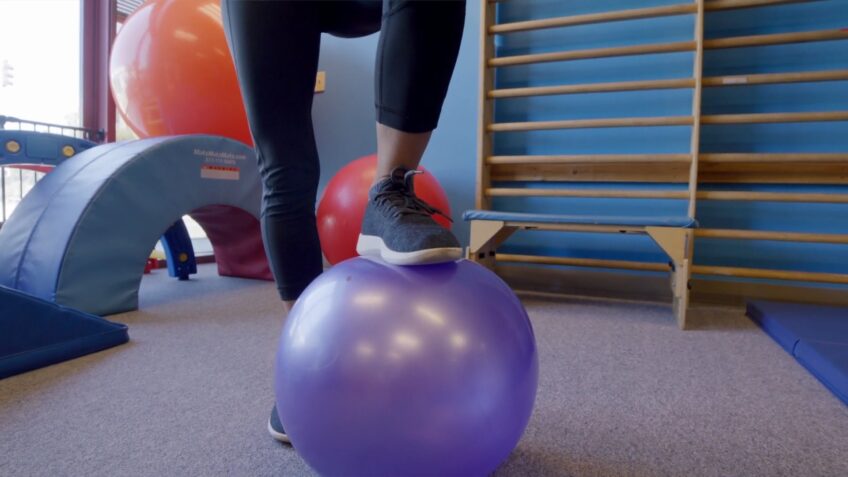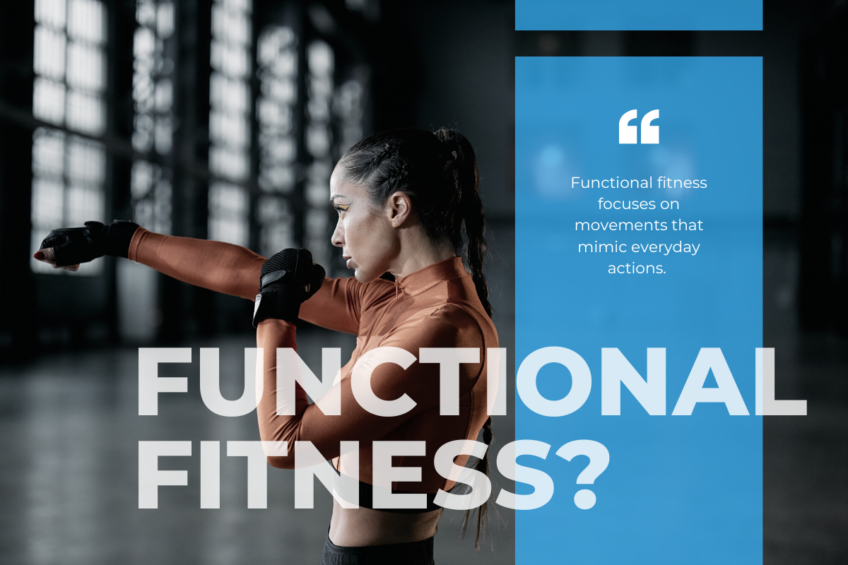Functional fitness focuses on movements that mimic everyday actions. These exercises incorporate multiple muscle groups at the same time for an efficient workout that will improve how your body moves outside of the gym. The program builds strength, balance and joint mobility along with improving your total fitness at each workout.
The movements that are part of the workouts simulate common movements you might do at home, at work, or in sports. Functional fitness is a great way to efficiently improve your strength and metabolism at the same time by not only improving your lean muscle mass but also your daily caloric burn.
Along with bodyweight movements, we utilize objects such as kettlebells, medicine balls, rowers and barbells. These items are especially effective because they support the way your body should move.
Exercises examples:

1. Barbell squats
Build leg strength for any squatting movement including getting on and off the toilet, in and out of the car and picking up and carrying any object such as a full laundry basket. Squats are the basis of everything we do and weak legs mean sore joints.
2. Kettle Bell Swings
A low-impact way to wake up all of your muscles that take a vacation when you sit too much. This exercise works the back of your legs and hips along with the upper muscles that don’t work when you are seated all day such as your chest, shoulders and core. This low-impact movement makes everything better when you move!
3. Overhead Presses
Upper body muscle is needed to turn your body over in bed, make a meal or get ready for your day. This movement builds strength and flexibility in the upper body to lift a suitcase and put it in the overhead of a plane by yourself!
4. Deadlift
Any time you have to pick something up from the ground and carry it you need these muscles for strength and to protect your lower back. This exercise mimics carrying in your groceries, lifting a bag of mulch, or picking up a child.
5. Rower
Because many cancer treatments cause neuropathy and balance challenges, the rower is a safe and effective way to build aerobic capacity safely. This exercise will help with everyday activities like climbing stairs without being winded.
Benefits of Functional Fitness Training

Functional fitness training has been shown to have a variety of benefits, including health and fitness improvements, reduction in injuries, and improved mental well-being. Here are six key reasons to consider adding functional fitness training to your routine:
1. Health and Fitness Improvements
One of the main benefits of functional fitness is that it can help improve your overall health. The workouts are designed to target specific muscle groups, helping you achieve a more balanced body composition and improved overall physical conditioning.
2. Reduction in Injuries
Studies have shown that functional fitness training can reduce the incidence of injuries by up to 50%. This is because the exercises are specifically tailored to address weaknesses and musculoskeletal imbalances that often lead to injury.
Additionally, working on balance and coordination is a key part of the training, which helps build strong muscles without putting pressure on joints or causing undue stress on the spine.
3. Improved Mental Well-Being

Another benefit is that it can improve mental well-being. This is because functional fitness works all over the body—not just isolated muscle groups—and involves movement that is typically associated with everyday activities like walking, cooking, cleaning, etc.
This type of exercise has been shown to increase self-confidence, mood stability, and resilience when faced with stressors in life. Additionally, many people find that this training provides an emotional release after periods of intense concentration or stress.
4. Increased Strength and Endurance
This is because functional training targets multiple muscle groups at once, which leads to a greater-than-average increase in overall muscle mass. Additionally, it helps you build muscular endurance by increasing the time you can perform an exercise before experiencing muscle fatigue.
5. Improved Balance and Coordination

Improvements in balance and coordination are another key benefit. These improvements can help you stay safe while performing other activities, such as walking or climbing stairs. Additionally, improved balance and coordination can protect you from injury by preventing falls.
6. Quicker Progress Toward Your Goals
You can speed up your progress toward your goals. While traditional cardio and weightlifting routines require time to see results, functional fitness offers fast results that last long-term.
FAQ
1. Is functional fitness the same as CrossFit?
The two are similar in that they emphasize strength, cardiovascular conditioning, and flexibility training. However, CrossFit is much more specific in its exercises and is designed to be challenging.
2. Is it good for weight loss?
3. Is yoga functional training?
Yoga is widely considered a functional training program, as it incorporates physical postures and breathing exercises to improve balance, flexibility, strength and energy. In fact, many yoga teachers also offer classes that focus on cardio and strength conditioning, making it an ideal program for athletes and those looking to increase their endurance.
4. How many days a week should you do functional training?
Aim to do at least one day a week, but working out every day can also be beneficial. Here are some guidelines for how many days a week you should do functional training:
– If you are just starting out, aim to work out on two days per week.
– If you are more experienced, you can work out on three or four days per week.
– Remember to focus on variety and make sure each workout is different so your muscles have a chance to adapt.
Final Words
In conclusion, functional fitness training is a type of exercise that can help you improve your overall fitness level and mobility. It’s a great choice for people who want to stay active and injury-free without spending hours in the gym. To start functional fitness training, consult with a physical therapist or doctor familiar with this type of exercise.
Don’t miss out on more exercises that will improve your health and fitness on webuild4life.com.

